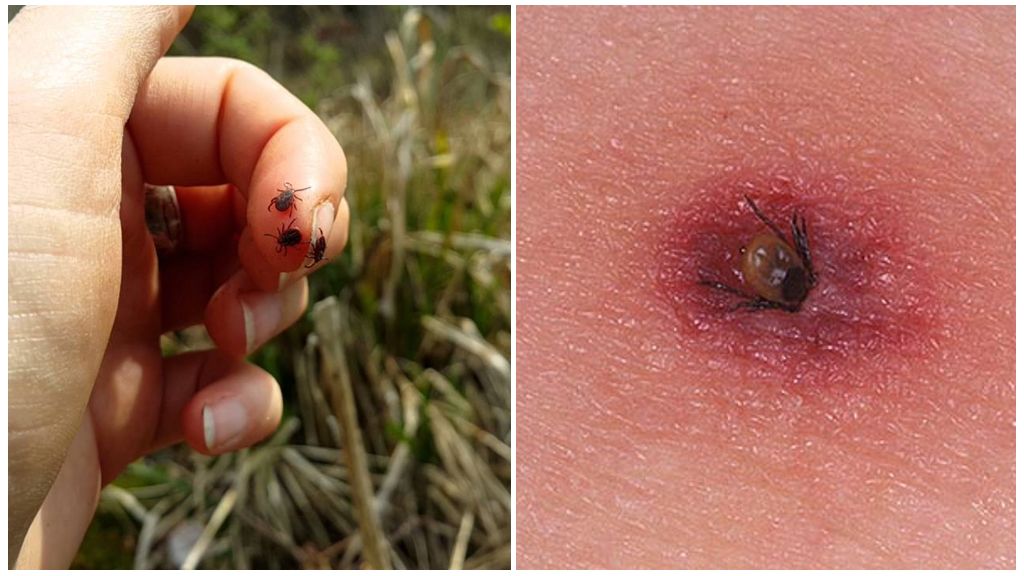- Tick bite
- Signs of tick-borne encephalitis
- Ticks
Ticks appeared on Earth many tens of millions of years ago, being contemporaries of giant reptiles, and have not changed much since then. With a high degree of probability, even then, in the Akari subclass there were species that ate a blood dinosaur. This may be an indirect confirmation of the warmth of the dinosaurs. The continents at that time were still a single whole, which allowed the ancestors of modern ticks to spread throughout the planet. In the process of evolution on already separate continents, new species of ticks arose from the original ones, forming a phylogenetic tree. Therefore, the question of where ticks came from in Russia is wrong. They existed on this territory long before the advent of states and even of Homo sapiens. But the legitimacy of ticks on Russian territory is of little concern to people, since the main concern of humanity today is the fight against diseases transmitted by these arthropods. So finding out the origin of ticks that carry encephalitis is much more relevant than their evolutionary history.
History of Encephalitis Tick
It is believed that until the mid 30s of the last century encephalitis in Russia and the Far East did not exist. And only after these years the encephalitis tick spread throughout Eurasia. There are two theories that answer the question of where encephalitis ticks came from.
Conspirological
It's all the Japanese to blame. In the 30s of the last century, outbreaks of an unknown disease were noticed in the Far East. The epidemic raged among the Far Eastern Red Army groupings.
The disease was first described in 1935 by A. G. Panov. In 1937, an expedition was sent there to find out the source of infection. The head of the expedition was Professor L.A. Zilbert. The work of the expedition was successful and the vector was found. It turned out to be ixodic taiga tick.
Since 1935, a laboratory for the production and testing of biological weapons operated by the "Detachment 731" has been operating in the territory of Manchuria. After the USSR entered the war with Japan, work was curtailed and the laboratory destroyed. We could not completely cover the traces; after the surrender of Japan, it turned out that the laboratory worked with various viruses, using various objects as carriers. From rats to mosquitoes.

On a note!
The Japanese also worked with encephalitis. But the strain of the virus was the one that carry mosquitoes. Japanese got it from mosquitoes. In the 1920s, an outbreak of mosquito encephalitis occurred in Japan, killing several thousand people. Mosquito encephalitis is a relative of tick-borne, but the strains are still different.
After returning to Moscow, the head of the expedition to the Far East was arrested. The charge was brought as a Japanese saboteur who brought tick-borne encephalitis to Russia.
Inconsistencies
The Japanese worked with mosquito encephalitis, which is different from tick-borne. Travelers to the Far East as early as the 1920s (10 years earlier) indicated that the local population was afraid of ticks. Indigenous peoples are more resistant to tick-borne encephalitis.
On a note!
Wild fauna is a carrier of the virus, but does not get sick.This indicates that the virus appeared in the taiga long before a person arrived there.
Encephalitis is a very unreliable biological weapon:
- serious consequences it causes only 20-30% of cases;
- even in disadvantaged areas only 20% of ticks are infected with the virus, and even less are safe;
- the virus is not transmitted directly from person to person;
- to force encephalitis tick it’s impossible to attack a person.
It’s easier to use plague-infected rats and fleas instead of ticks. It is these vectors that the Japanese actually used.
The one who invented ticks specially infected with encephalitis, pursued other goals: to remove the competitor. Regarding the alleged absence of encephalitis in Russia until the 1930s, one can dispense with the conspiracy theory.
Before the Great October Revolution, the tsarist government was not particularly interested in the state of affairs in the Far East. This region was a place of honor. Sometimes not honorable, but just links. With a high degree of probability, people were sick with encephalitis. But since at the first stage of development this disease is very similar to the flu or a cold, it was diagnosed without being able to do blood tests.
Interesting!
Encephalitis at that time "passed" in medical diagnoses as "toxic flu."
After the first stage of the disease, remission occurs (the person recovers), and the second stage occurs only in a third of patients. And few of the sick recalled a tick that bit him a month ago.
Only when the "flu" began to mow down military units, that is, organizations where there are a lot of people and everything is in sight, the leadership and doctors suspected that the cause of the epidemic was not in the usual infectious diseases and began to look for the source of the disease.

Modern genetic
The development of science and genetic research has allowed scientists to trace the origin and distribution of various animal species. But with ticks and encephalitis, everything became only more confused.
The most popular version of the spread of encephalitis today claims that the disease has always been in the Far East. In the villages she was sick, but did not understand what it was. With the beginning of the active development of the eastern part of Russia, cases of the disease became more frequent, and encephalitis began to spread to the West. The first case of the disease in Europe was recorded only in 1948 in the Czech Republic.
But in 2012, at an international conference in Irkutsk, Novosibirsk scientists expressed the opposite point of view. In their opinion, based on the analysis of a fragment of the nucleotide sequence, encephalitis spread from west to east.
There is a compromise point of view, the authors of which, based on the analysis of genome-wide sequences of TBEV from GenBank, consider Siberia to be the place of occurrence of encephalitis. The spread of the disease, in their opinion, went in parallel in both directions.
The hypothesis authors in their arguments use the same nucleotide chains and the same software to determine the time of occurrence of the virus.
On a note!
The time of the onset of the virus according to these hypotheses also varies greatly: from 2.25 to 5-7 thousand years. The Japanese obviously have nothing to do with it.
Given the resistance of wild fauna to the virus and the rather narrow spread of the virus despite the fact that ixodid ticks unless they live in ice, we can conclude that the spread of the virus north and south is restrained by some natural factor. In the case of artificially created biological weapons, such factors do not work.
More expeditions of the late 30s revealed 29 strains of the virus that exist in the wild. For biological weapons, such diversity is also uncharacteristic.
Therefore, the hypothesis of the independent occurrence of encephalitis in the forests of Eurasia seems more consistent. And from where, to where the virus actually spread, it is interesting only to scientists. Ordinary citizens are much more concerned today with the question of where ticks come from in such huge quantities.
How are things with encephalitis today?

If we adhere to conspiracy theories, then the plot is much easier to see in today's explosion of tick numbers. Even in the area of encephalitis 40 years ago, precautionary measures were taken more for the sake of reinsurance. It was difficult to “find” a tick in the forest. Today for 1 square. km researchers shoot 40 pcs. arthropods. And ordinary citizens complain that after each going out for a walk with a dog, at least 5 of these arachnids are removed from it and themselves.
Where there is no encephalitis, it is rampant pyroplasmosis. And the number of ticks infected with this disease significantly exceeds the number of encephalitis.
On a note!
Such an outbreak occurred due to the ban on DDT and the complete cessation of insecticide treatment of forests. Insecticides harmed nature by killing all insects, but they held back ticks. Today, the population of arthropods multiplies uncontrollably, and encephalitis slowly creeps into new regions of the country.
If forest treatment with pesticides is not restored, then all hope remains only for those very natural factors that restrained the spread of encephalitis before the invention of insecticides.






